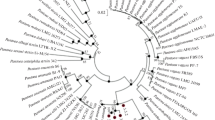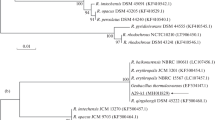Abstract
SomeArxula adeninivorans strains selected from wood hydrolysates in Siberia, from soil in South Africa and from maize silage and soil in The Netherlands were compared. DNA-fingerprinting, pulse field gel electrophoresis as well as analysis of secretory proteins have been chosen to describe the similarities among the strains. Combination of the three methods allowed identification of each strain. Strains from the same origin show extensive similarities. The results of the DNA-fingerprints indicate that the strain isolated in Siberia belongs to the group of strains originated from South Africa. However, it differed in the molecular weight of the third chromosome and in the pattern of secretory proteins from the South African isolates.
Similar content being viewed by others
References
Bradford M (1976) A rapid and sensitive method for the quantitation of microgram quantities of protein utilizing the principle of protein-dye binding. Anal. Biochem. 72: 248–254
Büttner R, Bode R & Birnbaum D (1987) Purification and characterization of the extracellular glucoamylase from the yeastTrichosporon adeninovorans. J. Basic Microbiol. 27: 299–308
Büttner R, Bode R, Scheidt A & Birnbaum D (1988) Isolation and some properties of two extracellular β-glucosidases fromTrichosporon adeninovorans. Acta Biotechnol. 6: 517–525
Büttner R, Bode R, Samsonova IA & Birnbaum D (1990) Mapping of the glucoamylase gene ofTrichosporon adeninovorans by mitotic haploidization using hybrids from protoplast fusions. J. Basic Microbiol. 30: 227–231
Büttner R, Bode R & Birnbaum D (1991) Comparative study of external and internal β-glucosidases and glucoamylase ofArxula adeninivorans. J. Basic Microbiol. 31: 423–428
—— (1992a) Purification and characterization of trehalase from the yeastArxula adeninivorans. Zbl. Mikrobiol. 147: 291–296
Büttern R & Bode R (1992b) Purification and characterization of β-xylosidase activities from the yeastArxula adeninivorans. J. Basic Microbiol. 32: 159–166
Gienow U, Kunze G, Schauer F, Bode R & Hofemeister J (1990) The yeast genusTrichosporon spec. LS3: molecular characterization of genomic complexity. Zbl. Mikrobiol. 145: 3–12
Görg A, Postel W, Weser J, Schiwara HW & Boesken WH (1985) Horizontal SDS electrophoresis in ultrathin pore-gradient gels for the analysis of urinary proteins. Sci. Tools 32: 5–9
Kunze G, Bode R, Schmidt H, Samsonova IA & Birnbaum D (1987) Identification of a lys2 mutant ofCandida maltosa by means of transformation. Curr. Genet. 11: 385–391
Kunze G, Kunze I, Barner A & Schulz R (1993) Classification ofSaccharomyces cerevisiae strains by genetical and biochemical methods. Brauwiss 4: 132–136
Laemmli UK (1970) Cleavage of structural protein during assembly of the head of bacteriophage T4. Nature (London) 227: 680–685
Ledeboer AM, Edens L, Maat J, Visser C, Bos JW, Verrips CT, Jawowicz Z, Eckart M, Roggenkamp R & Hollenberg CP (1985) Molecular cloning and characterization of a gene coding for methanol oxidase inHansenula polymorpha. Nucl. Acids Res. 13: 3063–3082
Middelhoven WJ, Hoogkamer-Te Niet MC & Kreger-Van Rij NJW (1984)Trichosporon adeninovorans sp. nov., a yeast species utilizing adenine, xanthine, uric acid, putrescine and primary n-alkylamines as the sole source of carbon, nitrogen and energy. Antonie van Leeuwenhoek 50: 369–378
Middelhoven WJ, Jong IM de & Winter M de (1991)Arxula adeninivorans, a yeast assimilating many nitrogenous and aromatic compounds. Antonie van Leeuwenhoek 59: 129–137
Middelhoven WJ, Coenen A, Kraakman B & Gelpke MDS (1992) Degradation of some phenols and hydroxybenzoates by the imperfect ascomycetous yeastsCandida parapsilodsis andArxula adeninivorans: evidence for an operative gentisate pathway. Antonie van Leeuwenhoek 62: 181–187
Smith CL, Klco S & Cantor CR (1988) Pulsed field gel electrophoresis and technology of large DNA molecules. In: Davis K (Ed) Genome Analysis, a Practical Approach. (pp 41–72) Oxford IRL Press, England
Tanaka A, Ohnishi N & Fukui S (1967) Studies on the formation of vitamins and their function in hydrocarbon fermentation. Production of vitamin B6 byCandida albicans in hydrocarbon medium. J. Ferment. Technol. 45: 617–623
Walt JP van der, Smith MT & Yamada Y (1990)Arxula gen. nov. (Candidaceae), a new anamorphic, arthroconidial yeast genus. Antonie van Leeuwenhoek 57: 59–61
Author information
Authors and Affiliations
Rights and permissions
About this article
Cite this article
Kunze, G., Kunze, I. Characterization ofArxula adeninivorans strains from different habitats. Antonie van Leeuwenhoek 65, 29–34 (1994). https://doi.org/10.1007/BF00878276
Received:
Accepted:
Issue Date:
DOI: https://doi.org/10.1007/BF00878276




